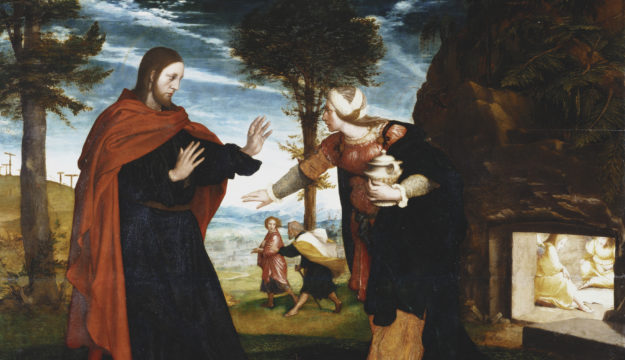 Hans Holbein the Younger, Noli me Tangere, 1526–8
©Royal Collection Trust©His Majesty King-Charles III 2023
Hans Holbein the Younger, Noli me Tangere, 1526–8
©Royal Collection Trust©His Majesty King-Charles III 2023
Holbein at the Tudor Court, The Queen’s Gallery, Buckingham Palace, 10 November 2023 – 14 April 2024
This winter, a major exhibition at The Queen’s Gallery, Buckingham Palace will bring together over 100 works from Henry VIII’s court, including drawings, paintings and miniatures by Hans Holbein the Younger drawn from the Royal Collection, one of the most important surviving groups of the artist’s work. Together, they will form the largest group of Holbein’s works from the Royal Collection to be exhibited in over 30 years.
Holbein at the Tudor Court will highlight works from Holbein’s time at court in the first half of the 16th century, when he rose to become the most important artist in Tudor England. This exhibition will tell the story of Holbein’s career in England, from itinerant artist to king’s painter, showing how the vibrant international court culture he found on his arrival in London formed a fertile ground for his future success.
The exhibition and accompanying publication will examine Holbein’s artistic techniques, his career in England and the lives of the men and women who commissioned his portraits, from members of the Tudor royal family to writers, churchmen and senior figures at court. Holbein’s skill as an artist was instrumental in cementing friendships, marking occasions such as marriage and as a tool in dynastic negotiations.
At the heart of the exhibition will be over 40 portrait drawings, which were probably acquired by Henry VIII at the artist’s death. These careful sketches, made in preparation for finished paintings, were taken during personal sittings, when Holbein sought to capture the essential features of his subject. Their survival allows us to come face to face with some of the key figures of the Tudor court, from Anne Boleyn to Sir Thomas More. While these extraordinary drawings cannot be on permanent display for conservation reasons, the exhibition will give visitors the opportunity to study them up close and see for themselves the exquisite skill that captured the imagination of the Tudor court almost 500 years ago.
The exhibition will feature two preparatory drawings alongside the resulting paintings. The comparison makes clear that the process of transfer was not a matter of simple copying from paper to panel, and that Holbein’s mastery of the portrait included the ability to flatter his subject through subtle alterations and emphases. Unusually for Holbein, one of these works, the portrait of William Reskimer, one of the Pages of Henry VIII’s Bedchamber, is painted on a reused panel.
Visitors will be introduced to paintings and decorative arts from the collections of Henry VII and Henry VIII, showing how the Tudor court was home to works from across Europe. Highlights include Guido Mazzoni’s terracotta bust of a young boy, once said to be Henry VIII as a child, and a portrait of Louis XII brought to England as part of the marriage negotiations between that monarch and Mary Tudor, Henry VIII’s sister.
The exhibition will explore Holbein’s arrival in England in 1526, and his first works for Sir Thomas More’s learned humanist circle. It will show his broadening appeal in the 1530s as he became the most sought-after portraitist at the Tudor court. Works will include drawings, paintings, miniatures and book illustrations by the artist and will tell the stories of his sitters through the portraits Holbein produced. Among them is a beautiful drawing of Mary Shelton, later Lady Heveningham, a cousin of Anne Boleyn and friend of poets such as Henry Howard, Earl of Surrey. Shelton, herself a poet, was one of the compilers of a significant anthology of Tudor verse.
Towards the end of his career, Holbein’s work for Henry VIII included portraits of the King’s wives and children, as well as depictions of Henry himself. Drawings of Princess Mary (later Mary I) and Prince Edward (later Edward VI) will sit alongside Holbein’s similarly dynastic portraits for the Howards, one of the most powerful families in Tudor England. The final section of the exhibition will show how, after his death, Holbein’s work influenced later Tudor artists such as Hans Eworth. Among the works displayed in this gallery will be Holbein’s drawings of Anne Boleyn and Jane Seymour, and a large portrait of Henry VIII and his family by an unknown artist who looks back to Holbein’s example, which had defined the image and faces of the Tudor court.
Kate Heard, curator of Holbein at the Tudor Court, said: ‘Holbein’s brilliant success at the Tudor court was due to his mastery of his art. His exquisite drawings and paintings were made using the techniques he had learned as an apprentice, but his impressive skill with these traditional materials saw him celebrated by contemporaries, as he is still celebrated today. It is easy to understand why the men and women of Henry VIII’s court sought a portrait from Holbein as a mark of success, a record of a loved one or a gift between friends.
‘Looking closely at the pieces in the exhibition, we can see Holbein at work, refining and altering as he goes to achieve the most perfect image that he can create. Close examination and technical analysis has allowed us to understand more about these endlessly fascinating works, which reveal so much about Holbein and his work as an artist in Tudor England.’





